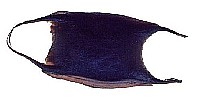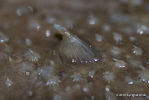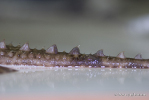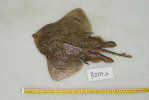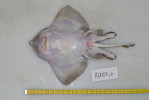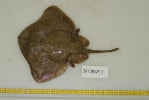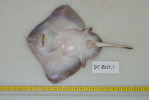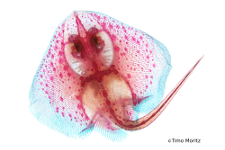Amblyraja radiata
(Donovan, 1808)
Thorny skate
Classification: Elasmobranchii Rajiformes Rajidae
Reference of the original description
The natural history of British fishes, including scientific and general descriptions of the most interesting species, and an extensive selection of accurately finished coloured plates. London: 1–516 unnumbered, Pls. 1–120. [v. 1, 1802:1–70, Pls. 1–24; v. 2, 1803:71–164, Pls. 25–48; v. 3, 1804:165–300, Pls. 49–72; v. 4, 1806:301–406, Pls. 73–96, v. 5, 1808: 407–516, Pls. 97–120.]
The natural history of British fishes, including scientific and general descriptions of the most interesting species, and an extensive selection of accurately finished coloured plates. London: 1–516 unnumbered, Pls. 1–120. [v. 1, 1802:1–70, Pls. 1–24; v. 2, 1803:71–164, Pls. 25–48; v. 3, 1804:165–300, Pls. 49–72; v. 4, 1806:301–406, Pls. 73–96, v. 5, 1808: 407–516, Pls. 97–120.]
Image of the original description
.jpg)
Amblyraja radiata (Donovan, 1808)
.jpg)
Amblyraja radiata (Donovan, 1808)
Synonyms / new combinations and misspellings
Amblyraja cf. radiata, Dasybatis radiata, Raia americana, Raia radiata, Raia scabrata, Raja americana, Raja radiata, Raja scabrata, Raja (Amblyraja) radiata, Raja (Raja) radiata
Amblyraja cf. radiata, Dasybatis radiata, Raia americana, Raia radiata, Raia scabrata, Raja americana, Raja radiata, Raja scabrata, Raja (Amblyraja) radiata, Raja (Raja) radiata
Types
Amblyraja radiata
Holotype: XXXX: No types known;
Raia scabrata
Syntype: MCZ: 254-S MCZ: 365-S MCZ: 1139-S MCZ: 1289-S
Amblyraja radiata
Holotype: XXXX: No types known;
Raia scabrata
Syntype: MCZ: 254-S MCZ: 365-S MCZ: 1139-S MCZ: 1289-S
Description :
Citation: Amblyraja radiata (Donovan, 1808): In: Database of modern sharks, rays and chimaeras, www.shark-references.com, World Wide Web electronic publication, Version 12/2025
Please send your images of "Amblyraja radiata" to info@shark-references.com
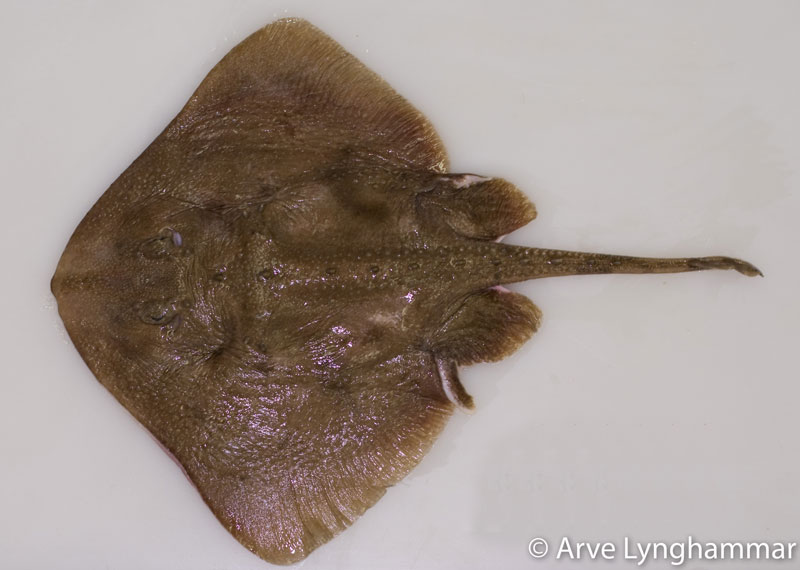
Amblyraja radiata (Donovan, 1808), © Arve Lynghammar, University of Tromsø, Norway

Amblyraja radiata (Donovan, 1808), © Arve Lynghammar, University of Tromsø, Norway
Common names
 Sternrochen,
Sternrochen,  Escrita,
Escrita,  Raya radiante,
Raya radiante,  Raie radiée,
Raie radiée,  Raie radiée épineuse,
Raie radiée épineuse,  Raie épineuse,
Raie épineuse,  Maiden ray,
Maiden ray,  Miller,
Miller,  Starry ray,
Starry ray,  Starry skate,
Starry skate,  Thornback,
Thornback,  Thorny back,
Thorny back,  Thorny skate,
Thorny skate,  Raia-repregada
Raia-repregada
 Sternrochen,
Sternrochen,  Escrita,
Escrita,  Raya radiante,
Raya radiante,  Raie radiée,
Raie radiée,  Raie radiée épineuse,
Raie radiée épineuse,  Raie épineuse,
Raie épineuse,  Maiden ray,
Maiden ray,  Miller,
Miller,  Starry ray,
Starry ray,  Starry skate,
Starry skate,  Thornback,
Thornback,  Thorny back,
Thorny back,  Thorny skate,
Thorny skate,  Raia-repregada
Raia-repregada
Short Description
Stiff, bluntly triangular snout and tail shorter than body [536]. Disc rhombic in adults, rounder in young [17658]. Upper surface very rough, with solid thornlets scattered all over disc and tail, underside smooth, except for some prickles on snout; a constant pattern of separate orbital thorns, a regular row of 13-17 large thorns from nape to first dorsal fin [7182]; large, close-set thorns with star-shaped bases at upper disc [536]. Brownish grey with scattered irregular black blotches dorsally; white ventrally, with darker spots and blotches on tail and pelvic fins; black spot on tip of tail [20085]. Diet: Barents Sea (data base: of 2192 stomachs examined): Thorny skate stomach contents consisted primarily of fish and large crustaceans (shrimps and crabs). Of more than 18 species of fish identified, young cod (Gadus morhua) (12% by mass) and capelin (Mallotus villosus) (6% by mass) were the most prevalent. Demersal crustaceans were represented mainly by northern shrimp (Pandalus borealis) (9% by mass). Fisheries waste, which was an important component in the diet of the skates, occurred in 12% of stomachs and was 35% of the mass of stomach contents. The importance of small food items (Gammaridea, Euphausiidae and Polychaeta) reduced with increasing length of skate, whereas the importance of large crustaceans and fish increased. [5910];
Stiff, bluntly triangular snout and tail shorter than body [536]. Disc rhombic in adults, rounder in young [17658]. Upper surface very rough, with solid thornlets scattered all over disc and tail, underside smooth, except for some prickles on snout; a constant pattern of separate orbital thorns, a regular row of 13-17 large thorns from nape to first dorsal fin [7182]; large, close-set thorns with star-shaped bases at upper disc [536]. Brownish grey with scattered irregular black blotches dorsally; white ventrally, with darker spots and blotches on tail and pelvic fins; black spot on tip of tail [20085]. Diet: Barents Sea (data base: of 2192 stomachs examined): Thorny skate stomach contents consisted primarily of fish and large crustaceans (shrimps and crabs). Of more than 18 species of fish identified, young cod (Gadus morhua) (12% by mass) and capelin (Mallotus villosus) (6% by mass) were the most prevalent. Demersal crustaceans were represented mainly by northern shrimp (Pandalus borealis) (9% by mass). Fisheries waste, which was an important component in the diet of the skates, occurred in 12% of stomachs and was 35% of the mass of stomach contents. The importance of small food items (Gammaridea, Euphausiidae and Polychaeta) reduced with increasing length of skate, whereas the importance of large crustaceans and fish increased. [5910];
Distribution
Eastern Atlantic: Svalbard, Greenland and Iceland to the English Channel, including the North Sea (except southern part) and the western part of the Baltic; also off Cape Town, South Africa [536]. Western Atlantic: Greenland and Hudson Bay, Canada to South Carolina, USA [17658]. Source: www.gbif.org
Eastern Atlantic: Svalbard, Greenland and Iceland to the English Channel, including the North Sea (except southern part) and the western part of the Baltic; also off Cape Town, South Africa [536]. Western Atlantic: Greenland and Hudson Bay, Canada to South Carolina, USA [17658]. Source: www.gbif.org
Human uses
fisheries: minor commercial; gamefish: yes; price category: medium; price reliability: very questionable: based on ex-vessel price for species in this family
fisheries: minor commercial; gamefish: yes; price category: medium; price reliability: very questionable: based on ex-vessel price for species in this family
Biology
Oviparous, paired eggs are laid. Embryos feed solely on yolk [733]. Distinct pairing with embrace. Young may tend to follow large objects, such as their mother [17086]. Produces 13-20 eggs in a year (Ref. 41250). A boreal to arctic species, living offshore on hard and soft bottoms at temperatures of -1.4-14°C. Parasites of the species include 3 protozoans, 1 turbellarian, 1 monogenean, 1 trematode, 10 cestodes, 5 nematodes and 4 copepods, found on the skin, digestive tract and body cavity (Ref. 5951).
Oviparous, paired eggs are laid. Embryos feed solely on yolk [733]. Distinct pairing with embrace. Young may tend to follow large objects, such as their mother [17086]. Produces 13-20 eggs in a year (Ref. 41250). A boreal to arctic species, living offshore on hard and soft bottoms at temperatures of -1.4-14°C. Parasites of the species include 3 protozoans, 1 turbellarian, 1 monogenean, 1 trematode, 10 cestodes, 5 nematodes and 4 copepods, found on the skin, digestive tract and body cavity (Ref. 5951).
Habitat
demersal; oceanodromous [17660]; brackish; marine; depth range 20 - 1000 m [7180], usually 50 - 100 m [7180]
demersal; oceanodromous [17660]; brackish; marine; depth range 20 - 1000 m [7180], usually 50 - 100 m [7180]
Remarks
shark-references Species-ID=209;
shark-references Species-ID=209;
Parasites (arranged by Jürgen Pollerspöck)
Kinetoplastea
Conoidasida
Monogenea
Cestoda
Trematoda
Nematoda
Copepoda
Isopoda
- Acanthochondrites annulatus (Olsson, 1869) [16598] [16560]
- Lafystius morhuanus Bousfield, 1987 [16606]
- Micropharynx parasitica Jaegerskiold, 1896 [23601]
Kinetoplastea
- Trypanosoma rajae Laveran & Mesnil, 1902 [21433]
Conoidasida
- Haemogregarina delagei Laveran & Mesnil, 1901 [21433]
Monogenea
- Acanthocotyle verrilli Goto, 1899 [17134] [17150] [17150] [17205] [17258] [29715]
- Calicotyle kroyeri Diesing, 1850 [17150] [15244] [17436] [23992] [7377]
- Dictyocotyle coeliaca Nybelin, 1941 [17150] [15076] [15251] [17436] [23992] [23432] [24899]
- Rajonchocotyle batis Cerfontaine, 1899 [17258]
- Rajonchocotyle emarginata (Olsson, 1876) [22565] [22485] [24074] [29715]
Cestoda
- Acanthobothrium coronatum (Rudolphi, 1819) Van Beneden, 1850 [12575] [16448]
- Anthobothrium cornucopia Van Beneden, 1850 [16324] [12575]
- Anthobothrium variabile (Linton, 1899) Wardle & Mcleod, 1952 [12575]
- Calyptrobothrium riggii Monticelli, 1893 [16443]
- Echeneibothrium canadensis Keeling & Burt, 1996 [16342] [12591] [16148] [7574]
- Echeneibothrium dubium abyssorum Campbell, 1977 [16275] [7574]
- Echeneibothrium variabile Van Beneden, 1850 [12575]
- Echinobothrium raji Heller, 1949 [16324] [16430] [19536]
- Grillotia (Grillotia) brayi Beveridge & Campbell, 2007 [7411]
- Grillotia (Grillotia) dollfusi Carvajal, 1971 [16112]
- Grillotia erinaceus (Van Beneden, 1858) [16112] [7411] [15747]
- Grillotia sp. [16324] [16112] [17504]
- Phormobothrium affine (Olsson, 1867) [17258]
- Phyllobothrium dagnallium Southwell, 1927 [16324]
- Phyllobothrium lactuca Van Beneden, 1850 [16443]
- Phyllobothrium sp. [12575] [16443]
- Phyllobothrium thridax (Van Beneden, 1849) [16443]
- Pseudanthobothrium hanseni Baer, 1956 [16248] [16148] [7574] [7413] [17504]
- Scyphophyllidium giganteum (Van Beneden, 1858) Woodland, 1927 [16324]
Trematoda
- Gonocerca phycidis Manter, 1925 [17258]
- Otodistomum cestoides (Van Beneden, 1871) [16324] [17258]
- Otodistomum veliporum (Creplin, 1837) Stafford, 1904 [22616] [12575]
Nematoda
- Anisakis simplex (Rudolphi, 1809) [17258]
- Anisakis sp. [12575]
- Contracaecum plagiostomorum (Linstow, 1905) [17029]
- Contracaecum sp. [17258]
- Pseudanisakis rotundata (Rudolphi, 1819) [12575] [19875]
- Pseudanisakis sp. [17504]
- Pseudanisakis tricupola Gibson, 1973 [17029] [17258] [31368]
Copepoda
- Caligus elongatus Von Nordmann, 1832 [16598]
- Dendrapta cameroni (Heller, 1949) [16324]
- Dendrapta cameroni cameroni (Heller, 1949) [16606]
- Eudactylina corrugata Bere, 1930 [16606]
- Eudactylina similis Scott, 1902 [16598]
- Lernaeopodina longimana (Olsson, 1869) [16598] [16606] [17258]
- Schistobrachia ramosa (Krøyer, 1863) [16606] [17258]
Isopoda








